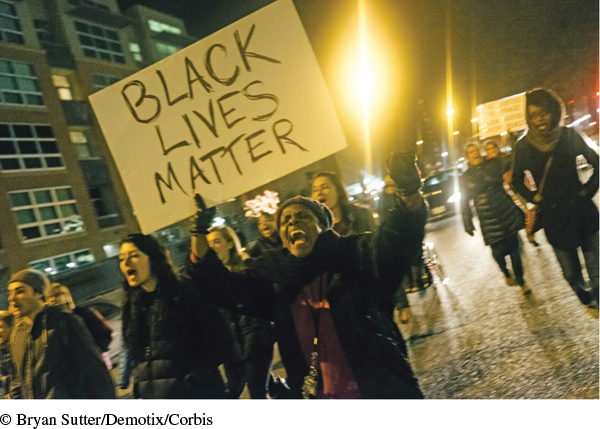Obama and Domestic Politics
In the midst of the Great Recession, the United States held the 2008 presidential election. The Republican candidate, John McCain, was a Vietnam War hero and a senator from Arizona. His Democratic opponent, Barack Obama, had served a mere four years in the Senate from Illinois. For their vice presidential running mates, McCain chose Sarah Palin, the first-term governor of Alaska, and Obama selected Joseph Biden, the senior senator from Delaware.
In the end, Obama overcame lingering racial prejudices in the country by speaking eloquently about his background as an interracial child, the son of an immigrant from Kenya and the grandson of a World War II veteran from Kansas. As important, the former community organizer succeeded in building a nationwide, grassroots political movement through digital technology. He raised an enormous amount of campaign money from ordinary donors through the Internet and used Web sites and text messaging to mobilize his supporters. Obama won the presidential election most of all because the public blamed the Bush administration for the recession, and Obama offered hope for economic recovery. Obama captured 53 percent of the popular vote, obtaining a majority of votes from African Americans, Latinos, women, and the young, who turned out in record numbers, and a comfortable 365 electoral votes. The Democrats also scored big victories in the House and Senate.
Yet the election of President Obama did not erase generations of racism or usher in what some have called a “postracial” America. From 1975 to 2002, the number of black elected officials in the United States increased from around 3,500 to more than 9,000. African Americans had also made significant economic progress as a result of antidiscrimination laws and affirmative action, expanding the size of the black middle class. However, the racial gap in wealth, education, and rates of incarceration remained wide. In 2010 the median income for blacks was $32,068, compared with $51,846 for whites. Whites were 25 percent more likely than blacks to own their home. By 2015 approximately 27 percent of African Americans (compared with 10 percent of whites) lived in poverty, nearly double the national poverty rate of 15 percent. The percentage of whites who received a bachelor’s degree was almost double that for blacks. More than 28 percent of black men were expected to be imprisoned during their lifetime, compared with 4 percent for whites.
Despite the persistence of racism, President Obama achieved notable victories during his first term in office. He continued the Bush administration’s bailout of collapsing banks and investment firms and expanded it to include American automobile companies, which within three years bounced back, became profitable again, and began paying back the government for the bailout. In 2009 the president supported passage of an economic stimulus plan that provided federal funds to state and local governments to create jobs and keep their employees, including teachers, on the public payroll. That same year, Congress also extended the period of unemployment insurance benefits. More controversially, President Obama pushed Congress to pass the Patient Protection and Affordable Care Act (dubbed “Obamacare”) in 2010, a reform measure mandating that all Americans had to obtain health insurance or face a tax penalty and that no one could be denied coverage for a preexisting condition. He also signed into law repeal of the “don’t ask, don’t tell” policy, which discriminated against gays in the military.
Despite many policy achievements, President Obama continued to encounter vigorous political opposition. Most Republican lawmakers refused to support his economic stimulus and health care reform bills. A group of Republican conservatives formed the Tea Party movement and attacked the president as a “socialist” for what they perceived as an effort to expand federal control over the economy and diminish individual liberty with the health care act. The rise of the Tea Party intensified the partisanship within the country and added to the growing gridlock in Washington, D.C. The Tea Party flexed its electoral muscle in the 2010 midterm elections, successfully campaigning for Republican congressional and gubernatorial candidates who supported its positions. And Republicans regained control of the House while the Democratic majority in the Senate narrowed.
Obama also encountered political difficulties from the left. Although the president saved the financial system from collapse, at the end of 2011 unemployment remained higher than 8 percent (a drop from its high of 10.2 percent). With millions of people still out of work, a resurgent Wall Street rewarded its managers and employees with big financial bonuses. Large corporations earned millions of dollars in profits but did not create new jobs. In 2011 protesters in cities around the nation launched the Occupy Wall Street movement, which attacked corporate greed, economic inequality, and government ineffectiveness. Many in the movement were inspired to act by declining tax revenues that led to crippling state budget deficits and massive cuts in spending on education, social services, and infrastructure. Many young people faced high unemployment and crushing student loan debts. They and other Americans were also deeply concerned about environmental issues, including dependence on foreign oil, global warming, and air and water pollution.
With unemployment remaining high, economic growth moving at a slow pace, and a number of European nations unable to pay mounting debts, the economy loomed as the top issue in the 2012 presidential election. The Republican nominee, Mitt Romney, the former governor of Massachusetts, appealed to conservative voters by opposing Obama’s economic programs, including health care reform, and by embracing the social agenda of the Christian Right. Despite the slower-than-expected economic recovery, Barack Obama won reelection by holding together his coalition of African American, Latino, female, young, and lower-income voters.
During President Obama’s second term, the economy showed greater improvement. The unemployment rate dropped to 4.9 percent in February 2016, the lowest figure in eight years. From 2010 to 2014, the gross domestic product grew steadily by an average of more than 2 percent, and the strengthening economy cut the budget deficit significantly. However, as the economy recovered from recession, real wages declined and income and wealth inequality widened. The top 1 percent gained about 95 percent of the income growth since 2009, and the top 10 percent held its highest share of income since World War I. One reason for this widening gap was that many jobs created by the recovery were low-wage service positions, whereas the wealthiest Americans benefited from the soaring stock market and rising capital gains.
In one area, gay rights, the Obama administration made great strides in its second term. Initially Obama had supported civil unions rather than gay marriage, but in 2012 he declared his support for same-sex marriage. The following year, the Supreme Court struck down the 1996 Defense of Marriage Act, thereby extending recognition of gay marriage. Finally, in 2015, in Obergefell v. Hodges the Court legalized same-sex marriage nationwide.

Still, Obama faced serious roadblocks to his legislative agenda. In the midterm elections of 2014, the Republicans won a majority of the Senate and controlled both houses of Congress. Proposals for immigration reform and gun control went down to defeat, as did raising taxes on the wealthiest Americans and increasing the federal minimum wage. At the same time, congressional Republicans tried to repeal Obamacare, and when that failed, they filed litigation to weaken it, but without success.
Racial conflicts also erupted despite the presence of an African American in the White House. Blacks had long-standing grievances with the criminal justice system; and the acquittal in 2013 of a white man in the shooting of Trayvon Martin, an unarmed black youth in Sanford, Florida, triggered outrage. Moreover, whereas most whites saw police officers as protectors, blacks viewed them with suspicion or as threats to their safety. A series of police killings of unarmed blacks in Ferguson, Missouri; Cleveland, Ohio; Staten Island, New York; and Baltimore, Maryland, renewed these fears and launched a movement that came to be known as Black Lives Matter. Technology helped spread its message through Twitter and social networking. As a result of federal investigations, in 2015 the Justice Department found a pattern of systemic racism and excessive use of force in the Ferguson and Cleveland police departments and negotiated settlements that instituted reforms. But here, too, persistent problems remained.

Exploring American HistoriesPrinted Page 987
Exploring American Histories Value EditionPrinted Page 729
Chapter Timeline